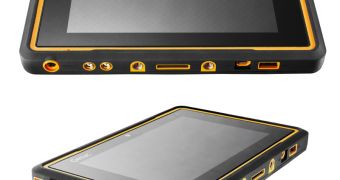Rugged Android tablets aren't all the common, since rugged devices are employed in industrial, medical and other such segments, where Windows is much more widespread.
Getac didn't mind releasing one though. In fact, the company even went out of its way to implement its LumiBond technology.
In a nutshell, LumiBond combines the durability of a Gorilla Glass panel with the light of an LED panel and the high sensitivity of a capacitive touch sensor.
It should be perfectly possible, convenient in fact, to use the Android 2.3 slate while wearing gloves. Since rugged tablets are supposed to be used in extreme conditions, which often means hot or cold temperatures, it would be counterintuitive for users to be forced to take their gloves off. After all, the human body doesn't do much better than regular technology in such situations.
“This unique feature will save time and boost productivity in sectors where users typically wear gloves to provide protection within hazardous working environments,” says Peter Molyneux, president, Getac Europe.
“We have built the rugged tablet with the operator in mind, whether they work in utility, logistics, automotive, or other field service sectors that require communication and data capture functionality, operating in harsh environments.”
We won't drone on and on about the performance specifications, since the product page has them well enough listed here and they aren't what Getac sees as most relevant anyway.
The company promises that the Z710, as the tablet is called, can safely operate between -20°C and 50°C (-4°F to 122 °F). When not in use, the storage temperature is of -40°C to 71°C (-40°F to 158°F). Getac also made sure that the Z710 is waterproof and capable of surviving six-foot drops.
A special mention was made of the unique GPS navigation processor (SiRFstarIV) and RF pass through (high-speed communications over Bluetooth, Wi-Fi and 3G).
Data capture VIA HW Barcode and high frequency RFID technology is possible as well, along with Geographic Information Systems (GIS) mapping (allowed by GPS, E-compass and the accelerometer).
“The device is engineered to enhance business performance on-the-go and in tough conditions – and we know users will be able to rely on the tablet to deliver time and again.” Mr Molyneux says.
“The RF pass-through provides faster and more reliable data delivery in real time, and with the corresponding in-vehicle docking station, the tablet becomes the ideal on-the-move communications solution.”

 14 DAY TRIAL //
14 DAY TRIAL //